Welcome to a new issue of the Journal of Runic Studies, the premier Malkioni publication for studies into the nature of Glorantha. If you haven’t subscribed yet, please consult with the spirit bound to the appropriate electronic page.
Chaosium News

Here are this week’s Chaosium news!
Vale and Farewell Steve Perrin (1946-2021)
The main news item is a sad one: Steve Perrin, whose name graced the cover of the first edition of RuneQuest back in 1976, passed away this week. Chaosium has a eulogy on their blog.

He is one of our Great Old Ones. An innovative genius who helped pave the way for us to exist today, delighting gamers while they sit around a table, in person or online, exploring stories and adventures together, weaving new tales of derring-do. RuneQuest and Superworld were his children, and his imprint on so many of our other games is indelibly present.

Steve Perrin had lately been crowdfunding and handling the care of his wife, Luise Perenne, whose name and art also graced the cover of the first edition of RuneQuest. Our thoughts are with her and their families.
I’m grateful for Steve’s work in roleplaying games and his involvement in Chaosium — my enjoyment of “tabletop pretend” would not be half as good if he hadn’t innovated and popularized the type of class-less, skill-based system that I’ve loved so dearly most of my life.
Thanks for all the severed left legs, Steve.
Steve Perrin’s latest works before his passing involved the new RuneQuest “Roleplaying in Glorantha” edition, and some of its published adventures. In a follow-up blog post, Chaosium vice-president Michael O’Brien talks about Steve’s work in RuneQuest’s two adventure collections to date, The Smoking Ruin and The Pegasus Plateau. In the former, he wrote “The Lost Valley” (a little adventuring sandbox with a diverse cast of NPCs to meet and deal with) and “Urvantan’s Tower” (which featured our first glimpse at Malkioni sorcery in action). In the latter, he wrote “The Pairing Stones” (which has some of my favourite art pieces in the book, some new mechanics for a fan-favourite Gloranthan material, and some scary encounters).
[…] Steve wrote “The Pairing Stones”, as those stones were named after he and his wife Luise, who painted the iconic cover that graces RuneQuest’s first and second editions, and provided interior illustrations for various early Chaosium releases. Pairing = Perrin, so something of a love letter.
If you read French (or know about Google Translate), the Anniceris blog has an interesting eulogy and biography of Steve Perrin, including references to his SPQR alternative rules, his possible involvement in inventing Black Panther, and a fantastic picture of Steve and Luise in SCA regalia at the 1968 Worldcon.
Steve Perrin: Creating RuneQuest
In addition to a few eulogies and touching words by Chaosium staff, we are getting a rare treat in the form of a six-part interview of Steve about the genesis of RuneQuest!
For our RuneQuest Classic Kickstarter in 2016 Steve Perrin generously provided a personal account of his role in the genesis of the RuneQuest roleplaying game. Although at the time of the Kickstarter we publicly featured an excerpt of Steve’s recollections, the full account was only ever published a high level backer item (in the RuneQuest Playtest Manuscript) and so only received limited circulation.
In memory of Steve, here we present his account in full as a six part series, offering his fascinating insights into the development of RuneQuest, the rules that cemented Steve Perrin as one of the most influential game designers of all time.
All six parts are available now from Chaosium’s blog:
- Part One: “The Chaosium’s role playing game”
- Part Two: Any character can do anything
- Part Three: Ha Ha in the Basement
- Part Four: Came the Ducks
- Part Five: An Ancient World Fantasy
- Part Six: Debut at Origins’78
This was just published as I woke up this morning, so I’m looking forward to dig into these articles over the next few days.
The White Bull Campaign
The “Chaosium house-campaign” continues their run through the “Dragon of Thunder Hills” adventure from the RuneQuest Gamemaster Pack. It’s always important to have a good poker face when you say “we have come to negotiate the terms of your surrender“.
Some Rare Wargaming Booklets with Glorantha as Setting Option
Chaosium president and expert collector/archivist Rick Meints wrote a short blog post about two rare wargaming booklets from Chaosium’s past: “Perilous Encounters” and the “Dragon Pass Conventions for Perilous Encounters”.
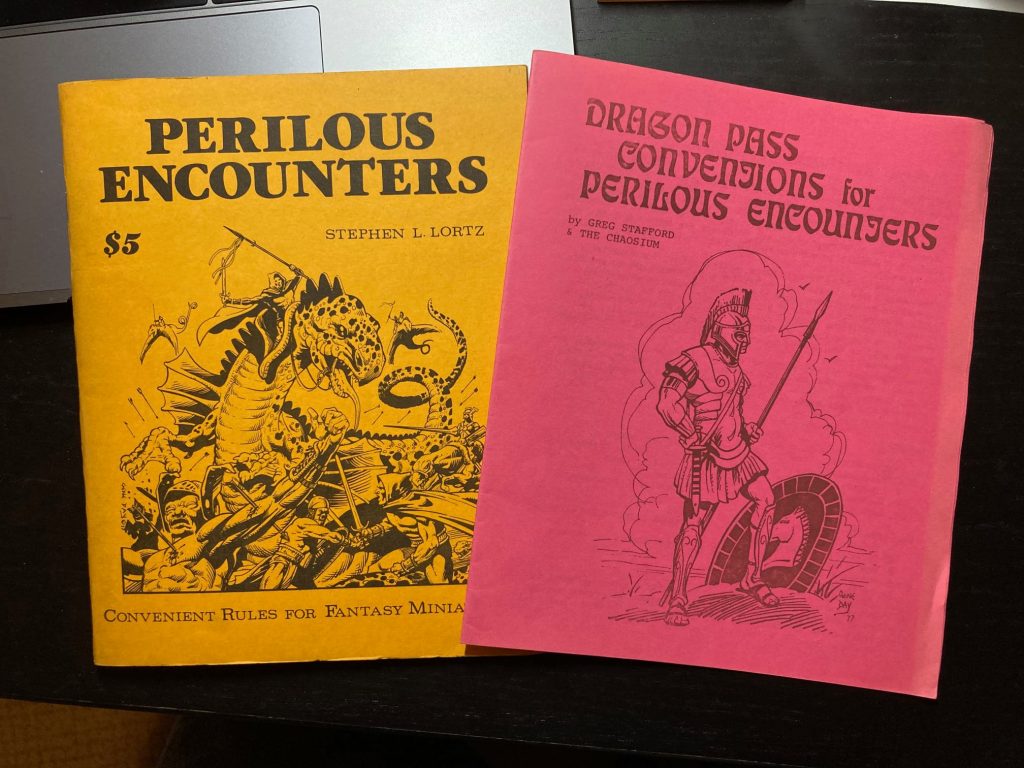
These are from the early wargaming years of Chaosium, so you have to go to BoardGameGeek (instead of RPGGeek) for reference (here and here). Interestingly, the cover picture from BoardGameGeek is white, as opposed to red in Rick’s picture… mmmh, I wonder if Chaosium has once again made various randomly-coloured versions of a product due to some equally random production limitation. My current vote is for something along the lines of “Greg ran out of red paper after about 800 copies, so the last 200 copies were printed on some white paper he found behind his desk. There may be also 6 copies printed on beige paper, because the pile of white paper was sitting on top of another pile“.
Anyway, Rick says:
During the height of our wargame years, The Chaosium published Steve Lortz’s Perilous Encounters in 1978. It featured the amazing art of Gene Day, most of which he had drawn previously in 1977. Its 44 pages of fantasy miniatures rules for beginners were described as “It has always been our intention to present the finest quality games for experienced game players, but it is also our intention to present the novice gamer with enjoyable and playable games of similar high caliber.” Don Dupont (Troy) and Nevile Stocken (Archive Miniatures), two early Chaosium collaborators, honed the project into its final form.
You may know Gene Day from his work at Marvel Comics, but he had already worked with Chaosium on Nomad Gods, for instance. That’s not the only time Chaosium worked with soon-to-be famous comicbook artists either: you can find some early work by Hellboy creator Mike Mignola in the pages of Wyrm’s Footnotes.
RuneQuest Starter Set Release Dates… Maybe
Over on BRP Central, Rick Meints (him, again!) shares some details on the possible release date for the RuneQuest Starter Set:
[End of September availability in the UK] for the Starter set is probably optimistic. We’ll have the books in our US warehouse by then, and they will be available to distributors some time in late September. Unfortunately, your UK game shop has to get the books from a distributor that has to order those books from our US warehouse and have them shipped to the UK. That makes me think maybe November at the earliest for an appearance in UK game shops. We’ll be selling the Starter set on our website for probably 2 months prior to that UK game shop debut, and offering shipping from our UK warehouse.
Please note that our UK warehouse is very expensive when it comes to storing product. Thus, we can’t have stock it with enough books to support distributor and game shop orders. We mainly have it for our UK fans who want to buy direct from us, and as soon as the product is available.

It’s important to note that the international shipping situation is a complete and utter mess right now. Shipping quotes have skyrocketed between last year and this year, and the global pandemic that is now part of our life has added delays at various checkpoints. And that’s when there isn’t a big ship stuck in the Suez canal (at least, we got some funny memes from that one).
Munchkin, Car Wars, GURPS, and Fantasy Trip (among others) publisher Steve Jackson Games (another gaming company I dearly love) is often very open with their fans when it comes to their production pipeline and financial situation, especially with their yearly “Report to Stakeholders“. Well, see what they have to say about this whole shipping debacle:
Global shipping is a nightmare. We have already posted a few Daily Illuminator entries about the state of freight (May 23, June 29), and things are not getting better. Freight costs were once a part of the business; now those costs threaten to devastate publishers.
As an example of how freight is impacting games, our Car Wars Sixth Edition project required five containers (all on the water, and slowly making their way to our primary warehouse) that each cost over 3x more than they would have if the game had shipped in 2020. As many of you know, 2020 was the planned shipdate . . . and then a global pandemic decided to enter the picture and completely disrupt our plan and the manufacturing schedule.
These freight costs are tearing into already-thin margins for many publishers, and some publishers are being forced to make decisions between shipping now and losing money, or holding inventory at the factory – and losing money.
Many other publishers replied on social media to say, basically “yep, they’re right: it’s bad“.
Silver lining: these days when my wife rolls her eyes at “yet another game purchase“, I can say that I’m just trying to support creators and gaming stores… she can’t argue against that!
GROGNARDIA Interviews Rick Meints
I somehow missed this a few weeks ago, but the excellent blog GROGNARDIA (which we mentioned a few times already in these parts) has a two-part interview of Chaosium president Rick Meints (part 1 and part 2). The interview covers large periods of Rick’s fandom and career, and how one morphed into the other.
RuneQuest for Fantasy Grounds
Progress continues for being able to play RuneQuest on the Fantasy Grounds VTT (where Chaosium already has many Call of Cthulhu items available). As far as I know, the goal is to have this ready by the time the Starter Set ships to customers and stores.

Jonstown Compendium

The Jonstown Compendium is Chaosium’s community content program for all Gloranthan games, hosted on DriveThruRPG. Disclaimer: all the relevant links are affiliate links that hopefully will let us cover some of the hosting and maintenance costs for the website and podcast! Thanks for using them!
Print-on-Demand Proofs for the Company of the Dragon
The Company of the Dragon is coming soon in POD! Andrew Logan Montgomery shared this picture on the RuneQuest Facebook group:
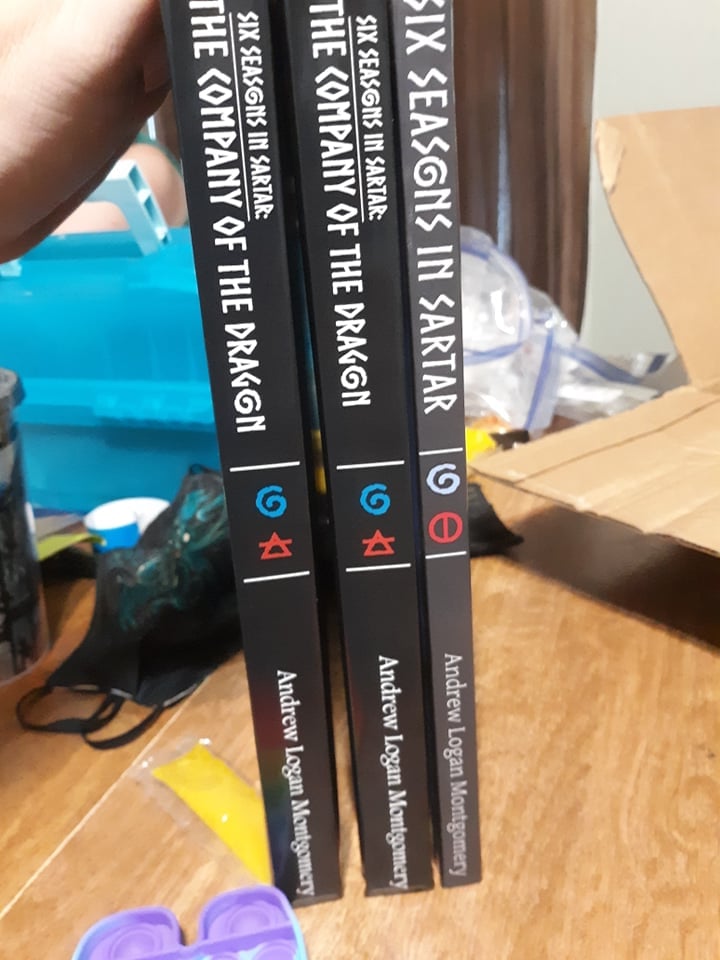
Andrew also notes the following about prices:
The recent price hike on the Premium color did make a big difference. Print costs on the Premium look to be $45 US with Standard being $20. I am glad I did both, because $25 is a big difference in these times. So those prices will have the actual cost of the book tacked on ($29.99 as it stands now, BUT I will be putting them both on sale the first month with about $10 knocked off the price on my end).
Of course, this may change a bit by the time the books are released, so don’t let anybody get mad at Andrew if he changes the price points!
Two Jonstown Compendium Products Contending for the Ennies
Big congratulations to Allan Carey, Chris Gidlow (twice!), Mike Hagen, Nick Brooke, Michael O’Brien, Jeff Richard, and Greg Stafford for being nominated in the “Community Content” category of the 2021 Ennie Awards.
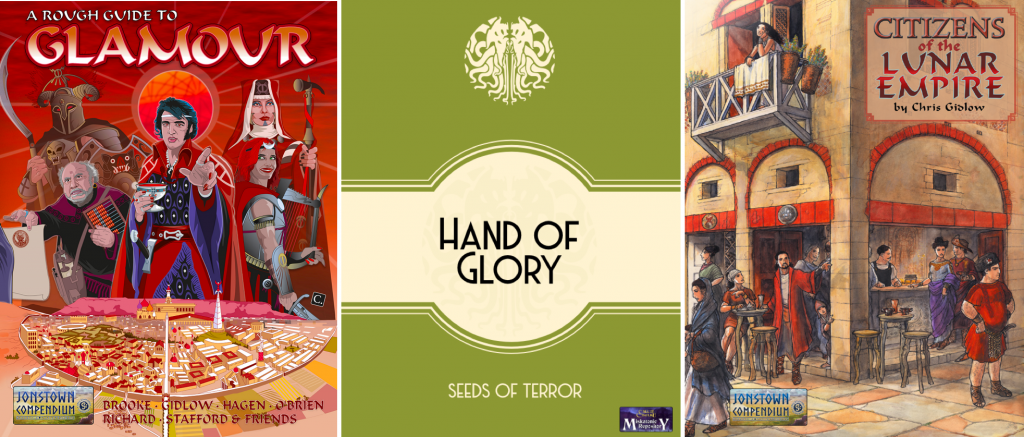
And yes, that category is weirdly repurposed from the older “Organized Play” category for some reason, even if it doesn’t look like the same thing at all to me… Anyway, voting opens next week, so be ready to show some love to Miskatonic University and Jonstown Compendium authors! We’ll give you the link for that in next week’s newsletter if there’s still time for that, otherwise you can follow us on Twitter or Facebook for more real-time updates.
Community Roundup
The community roundup is our highlight of interesting things being mentioned in the Glorantha-related Facebook groups, sub-Reddits, and other similar online places.
Comparing the Peaks of Dragon Pass
While working on the master map of Dragon Pass (which will feature in the upcoming Sartar Homeland boxed set), Chaosium cartographer Matt Ryan made this sketch to get a good idea of how the main peaks of the region compare to each other:
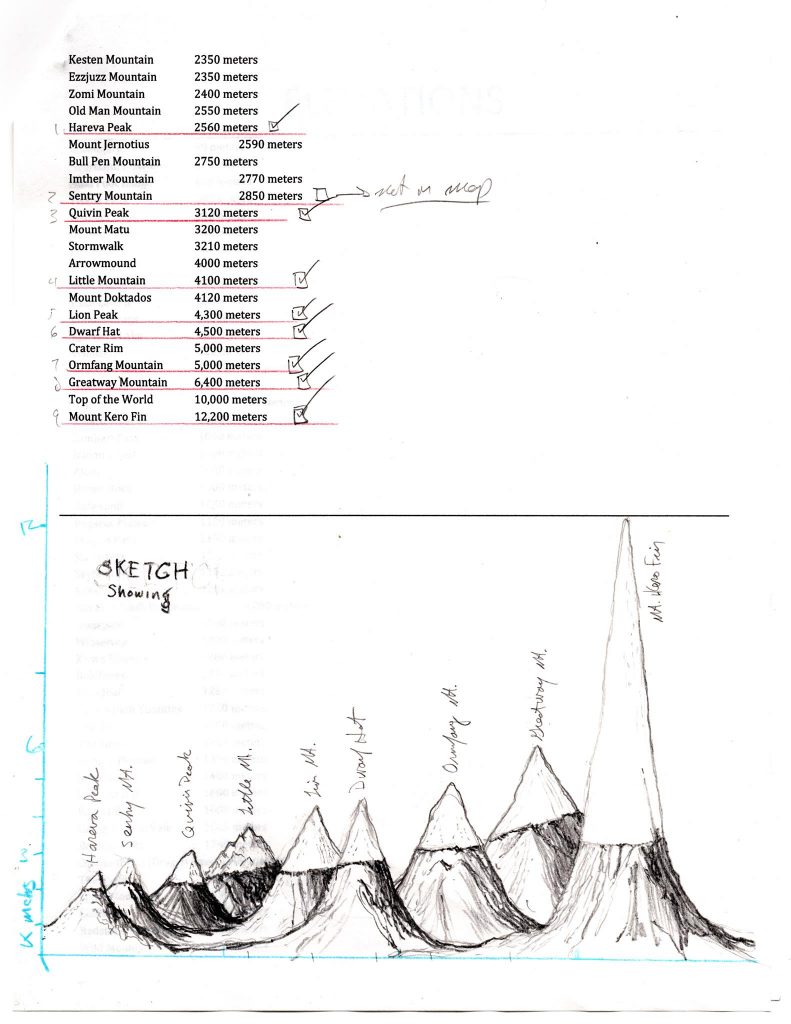
The Elmal vs Yelmalio Clarifications Continue
This is the topic that keeps on giving! I assume this will never get settled with some people, but I found this message from Jeff, on BRP Central, pretty interesting:
By the 1540s, the Elmal cult in Sartar was spiritually disintegrated under the influence of the Lunar Heartlands and the Yelm cult. Yelm IS the Sun. There’s just no way around that – the Yelm cult can prove that, have massive resources for proving it, know the mythic pathways of the Sun a thousand times better than any Orlanthi sun worshiper, and so on. And so many Elmali embraced Yelm. These Elmali waged war against their clans and tribes, murdered a Prince of Sartar, etc. Really bad stuff that nearly destroyed Sartar.
We know some of this from the Glorantha Sourcebook and King of Sartar. I’m pretty sure that the Elmali worshippers of Sartar getting cozier and cozier over the years with the Dara Happan Yelm cults wasn’t making them very popular with their Storm-worshipping neighbours… there are a couple mentions of Elmali clans disintegrating, getting into feuds, and refusing the Prince of Sartar’s call to arms.
The bit about murdering a Prince of Sartar is more obscure. In King of Sartar (2nd edition) Prince Jarosar is said to have been “killed by Lunar spirits” (p154), but also poisoned “from a friend’s hand” (p30). We know that King of Sartar is often vague and contradictory on purpose, so you can go with whichever option you want, but we know that Jeff goes with the second option, and more specifically that he attributes this “friend’s hand” to some treacherous Elmali:
Yes, the friend was an Elmali. And the Elmali thorough [sic] screwed Jarolar and Jarosar. The growing Yelmalio cult on the other hand aided Dorasor in settling New Pavis and aided Tarkalor against the trolls.
Back to the original message:
Monrogh righted all of that, by showing that Elmal is just a name for YELMALIO. Who is not Yelm. Who has his own myths and paths that Yelm does not know. Who persevered in the Darkness and was never extinguished (unlike Yelm). Monrogh could prove this and you could experience this as well. This wasn’t some syncretic religious argument – you would start the ceremonies to Elmal and Monrogh would show you how to go further into the rites and have the clouds cleared, the haze removed, and see the brilliant true light.
Here we are definitely in the “magical challenges” territory. You may want to check back on what Jeff said about those in issue 6 of the Journal, and how that applied to Monrogh and Yelmalio in issue 7.
This went fast – by the 1560s there was a Yelmalio cult in Sartar that fought the trolls, supported the House of Sartar, supported the rights of the Earth Temples – you name it.
The name Elmal was by then a byword for treason, murder, and kinstrife.
So now, the Yelmalio cult is how Sartarites worship the Light. Yelmalio is a frenemy of Orlanth, which is not uncommon in polytheistic pantheons. But the Orlanth cult supports Yelmalio, and Orlanth Rex has built him fine temples (include the Sun Dome temple). And that basically is the end of the story.

This really helped me better understand how, except for a couple hundred holdouts near Runegate, the Elmali cultists mostly left their tribes and settled in the (then new) Sun Dome County. The key, at least for me and my Glorantha, is to frame it as a win-win-win solution for these Elmali: they reach a deeper (and more powerful!) understanding of their God, they form a new tribe in which they can do all the sun-worship they want without getting angry looks from the other storm-worshiping villagers, and they restore their social and political position within the Kingdom of Sartar. Seems like a no-brainer to me. Of course the devil is in the details, but I don’t think I need to look at it too closely unless I intend to play a game set in the late 1500s, when all of this happened.
I will still definitely have a handful of weirdo conservative Elmali here and there in my Glorantha, whenever I need some “colourful NPCs”. I will definitely play them with a silly southern US accent.
More on the Pockets of Boldhome
As Jeff continues to flesh out Boldhome for the upcoming Sartar Homeland boxed set, he shares some art and words on Facebook:
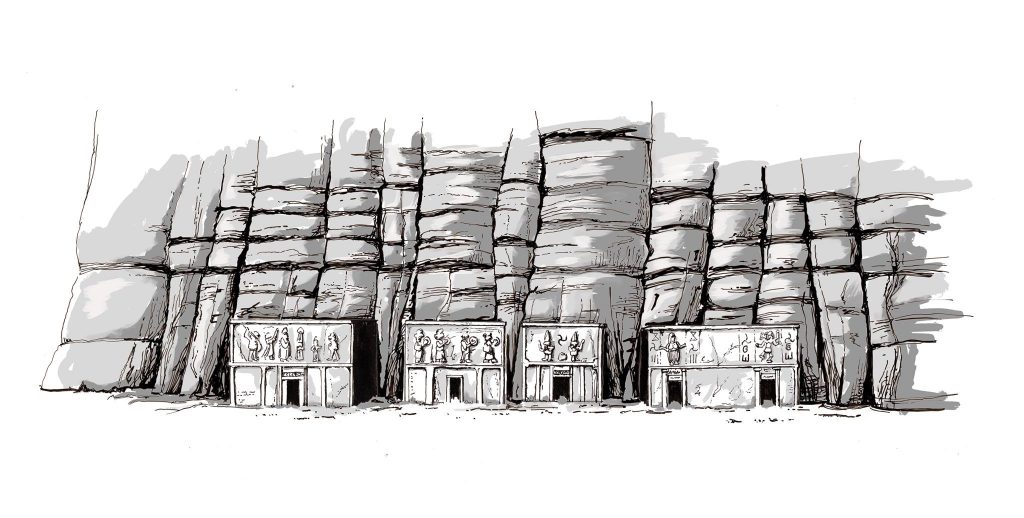
The “pockets” of Boldhome are dwarven-built directly into the cliffs of the mountain. They are organized in “terraces” (multiple levels) and “galleries” (collections of dwellings on the same level). A gallery holds “many families, usually organized around guild, clan, or cult activities“.
Galleries typically have a large communal eating area or feasting hall. These include storage rooms, kitchens, and private dining rooms. They are typically named after the gallery, so the Bonesmith Feasting Hall, etc.
Each gallery has numerous hearths. These are residences, where families sleep, weave, keep their possessions. There are typically chambers near the hearths for funerary urns, and shrines to the family gods. There are channels with running water, some of which have stone latrines built over them. They are lit by fires that are ventilated by mysterious dwarf-made chimneys.

Galleries have common spaces too: shrines to Lightbringer and Earth deities, kilns and forges, baths and steam rooms (which also feature more mysterious dwarven chimneys).
At the very rear of each gallery is a sacred Air shrine, where all the Mostali chimneys and tunnels gather. This chamber appears as vents that runs from the lowest terrace to the open air. Air rushes in and out of these vents, assisted by air elementals and spirits. There are shrines to the Breather Within where the inhabitants call upon the powers of Air to keep the Pocket habitable. During the Lunar Occupation, these served as a hidden Temple to Orlanth Victorious, where the god was worship despite the Lunar ban.
I wonder if some of these air elementals accept sacrifices to extra-ventilate when you stink up the latrines? Or to infiltrate someone’s personal quarters? (I don’t know how wealthy pocket-dwellers might be… Joerg thinks this is mostly middle and lower class people)
An important thing to note is that Jeff is heavily implying that many of Boldhome’s designs might be used “the wrong way” by its human inhabitants. The city’s architecture was commissioned by Sartar himself but only the Dwarves know what some of these chimneys and mechanisms are for. They might have wrongly assumed what humans need to live, and humans might have wrongly assumed what the Dwarves built for them. This is some good opportunity for a couple of scenarios where some city building or infrastructure starts “misbehaving” in a totally obscure or unexpected way!
Notes on Saird
Jeff shared a map of Saird, part of the Lunar Provinces, to show how urbanized and populated it is:
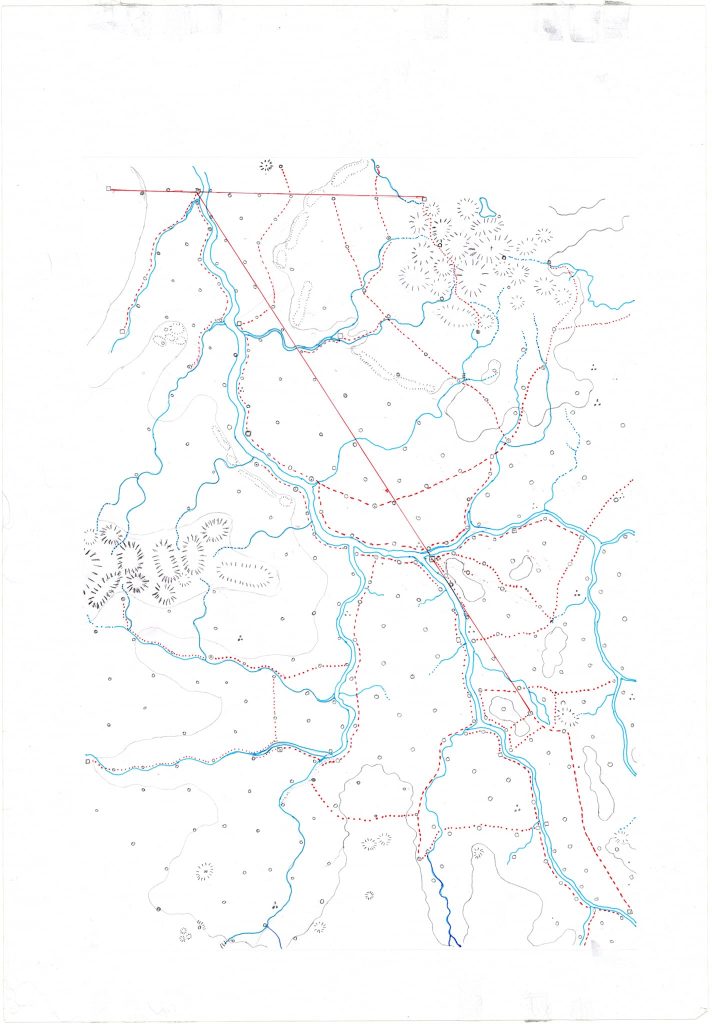
With every one of these dots being a town (Joerg tells me these would be between 500 and 1000 inhabitants each), that’s a lot of people! The Daughter’s Road that you can see diagonally crossing the land is bound to be a very busy mode of transportation, and somewhat of a symbol of pride for the locals, for it predates, say, the Sartarite Roads by at least a century! The “daughter” in question, who built the roads, is now worshipped as a goddess in the Lunar Pantheon as “Hwarin Dalthippa, the Conquering Daughter”. There’s a whole bunch of material in the Guide about her.
Given its geographical location, Saird is “where Dragon Pass and lowland Peloria like to fight their wars“. And indeed, it was when the Conquering Daughter invaded some of these lands that Arim the Pauper braved the Deathline and entered Dragon Pass to build the Kingdom of Tarsh, about the same time the Hendriki also entered it from the south as the first tribes of the future Kingdom of Sartar.
Now, this is where I often get confused: some Gloranthan names relate to geographical locations, while others relate to nations and settled areas. I’m never sure which is which… I think that Saird is a geographical location. As such, it overlaps with nations such as Holay and Aggar and maybe even Vanch. I think? Maybe? Hold on, I’m going to go ask Joerg.
Joerg here: Saird is indeed used as the name of a region containing the current kingdoms of Vanch, Imther, Holay, Aggar (at least the lowland parts), and a huge part of Sylila. But then the borders of these successor kingdoms varied within Lunar history (as can be seen in the Sourcebook).
In the Second Age, the Kingdom of Saird was created in opposition to the EWF, and received one of the three sons of the heiress of Carmania and the Emperor of Dara Happa as its king.
As far as I can see, there was no earlier occasion that would have had Saird as a unified political entity. The Dawn Survival sites show many different human cultures, quite a few of these under Troll overlordship. In the Bright Empire, the area saw the establishment of Sun Dome Temples, the cult of Palangio, the Iron Vrok, who became governor and conqueror of the Orlanthi outside of the Bright Empire (except for Fronela).
Thanks Joerg. Anyway, back to Jeff’s notes. He describes Saird as “the original “homeland” of the Yelmalio cult“. I’m pretty out of my depth on these topics so here’s a bunch of big quotes from Jeff… apologies, but I can’t effectively summarize this amount of information:
Between 375 and 425, there was an incredible mixing of cults and cultures in Saird. The Orlanth Thunderous cult was suppressed, many of the Wind Lords worshiped a mortal demigod as the incarnation of High Storm – we all know the story. Rebels like the old Berenething tribe were exterminated in Saird and their lands given to those loyal to the Broken Council. But outside of the Orlanth cult was a tremendous exploration of the paths of Light, encouraged by the Broken Council (and their new Light God). The Sons of the Sun were powerful and popular, and later given rule over Dragon Pass, with its unruly tribes, trolls, and dragonewts.
By “we all know the story”, of course, Jeff means “Gloranthaphiles may know the story”. I totally don’t! I have no idea who that mortal demigod is, but judging from a quick search in the Guide, and from the comments on Facebook, it might be Lokamayadon, priest of Nysalor who “usurped Orlanth’s place in [the Heortlings’] temples“.
Arkat and his troll, Orlanthi, and Praxian allies defeated the Sons of the Sun and rule was given to the trolls. The Yelmalio cult (which were the spiritual heirs of the Sons of the Sun) overthrew the trolls in Saird. Although they initially fought against Dragon Pass, they soon joined the Empire of Wyrms Friends and became an important military arm of the EWF and aided in the conquest of Dara Happa. Sun Dome temples were built from Fronela to Prax.
But the Empire of the Wyrms Friends was forced out of Saird in 956 by a coalition of Carmanians, Dara Happans, and Orlanth Rex warlords, ruled by cadet branch of the very heterodox Karvanyar Dynasty. For almost 200 years, Saird was a melting point of Yelmalion, Orlanthi, Dara Happan, and Carmanian cultures. Chaos and dragons were identified with Ganesatarus the Devil, the Lodril cult was imported but Dendara did not take, every man was the Last Light against the dragons, and Yelm and Orlanth were viewed as the Rival Brothers – who would naturally quarrel unless held together for a greater purpose (usually by Yelmalio). Real world analogies – the Mitanni, Seleucid Syria, Lydia, etc.
Then came the Dragonkill War of 1120. The dynasty was extinguished, and Saird was briefly conquered by Dara Happa. When Dara Happa was dissected by the Carmanian Empire, Saird became dominated by Orlanthi and (to a lesser extent) Yelmalion tribes. When the Mad Sultanate showed up, the tribes were horrified by the Chaos brought by the new Lunar Empire. Many Sairdite tribes followed Jannisor in his Great War against the Lunar Empire (1270-1275) and were defeated at their moment of victory inside Glamour.
As the Lunar Empire marched south, conquering Sylila in 1309, the Sairdite tribes unified into the Kynnelfing Alliance, but were ultimately defeated by Hwarin Dalthippa in 1347. This sent the most anti-Lunar groups south across the Death Line into Dragon Pass. In Saird, the Seven Mothers and Hwarin Dalthippa became important cults. Over the next century, Saird became a battleground between mostly Orlanthi Tarshites and the Lunar satrapy of Sylila.
A stable Provincial system didn’t really come into existence until 1555 (Phargentes was the first Provincial Overseer). Hon-eel early had came to Saird with her maize en route to Tarsh, and by now (1625) about a third of the population follows the Lunar Way. The Yelmalio cult is still important, although secondary to the Seven Mothers and Ernalda, and the Orlanth cult holds on with surprisingly large numbers, although largely subsumed into Barntar. Many peasants are descended from Pelorian colonists and worship Lodril instead.
And because of course everything goes back to debates about Yelmalio’s cult:
Now Monrogh only shows up into this story after around 1582 or so. The Provincial Kings, seeking military allies, encourage the local Yelmalio cult to organise along Monrogh’s lines and into Sun Domes, thus returning the cult back to where it was in the Second Age, as valuable mercenaries for whoever is the regional ruler.
But you can see from this, Yelmalio has been around in Peloria since the beginning.
The only weird thing was the Hendriki Tribe that worshiped a limited and constrained version of Yelmalio. But now the Sartarites are the cultural centre of a reinvigorated Yelmalio cult.
When you tell the story from this perspective, the Praxian Sun Dome Temple is just a weird footnote (“did you know that Yelmalio made it all the way to Prax in the Second Age, and there is a weird little colony of them still there! Wow!”), and the whole Elmal-Yelmalio thing becomes another footnote (“did you know that the rebellious Hendriking tribe had a weird little Yelmalio variant that was tolerated by the trolls and the Only Old One, but it died out in the 1550s when they embraced the larger Yelmalio cult?”).
[…]
Although Yelmalio is associated with Yelm, the Yelmalio cult is autonomous. Within the Lunar Heartlands, the Yelmalio cult is of course subject to the Red Emperor and his satraps, but so is almost every other cult (Red Goddess, Seven Mothers, Lodril, Dendara, Polaris, even Shargash). In the Lunar Provinces this gets a bit trickier. The Provincial Overseer has rule over the Provinces, and many Sun Dome Temples have treaties of alliance with individual provincial kings. Plus there are likely some long-standing contracts between the Lunar rulers and individual Sun Dome Temples.
But the Provincial Overseer is dead. Many provincial leaders lack the coin to pay their contracts, and besides the Lunar Empire is a bit preoccupied right now with a Pentan invasion and a White Moon uprising.
Thus in the Hero Wars, individual Sun Dome Temples will go their own way, fight both for and against the Lunar Empire. But Yelmalio dislikes the Red Goddess, so the Lunars need to pay extra.
Jeff concludes:
So I encourage you to imagine Saird as a densely populated and very urbanised place with three large cities (including one metropolis) but also with many rural tribes who often play kingmaker in city politics. The Daughter’s Road runs through it on its way to Jillaro.
The three large cities are all within 90 km of each other (Mirin’s Cross and Fyllich Kwan are only 50 km apart). It is a melting pot, with Lunar missionaries, bureaucrats, and officers, Yelmalion Sun Domers, Earth Priestesses, other Lightbringers, Dara Happan nobles and Lodrilli peasants, all jostling against each other.
If you want some ideas, notes, and unofficial maps to play in Imther or Holay, Harald “Jajagappa” Smith has got you covered with links and resources from himself and other community members.
Elsewhere on Arachne Solara’s Web
Not everything is about Glorantha, although most things are! Here are loosely relevant things that we found on the interwebs.
RuneQuest Actual Plays and Play Reports
If Jeff’s White Bull Campaign is not enough to quench your thirst of watching or listening to other people playing RuneQuest, I’ve got a couple more links for you!
Bryon Ross has an ongoing “video log” series where he gives short (~15 minutes) reports of his RuneQuest games. He also often links to the recording of the actual game itself, in case you want to watch how things actually unfolded. For instance, the game for the play report above is here.
Another actual play series, this time in audio form, is from the “Pen & Paper Bullshit” podcast. Their latest RuneQuest episode is here.
Both Bryon and Pen & Paper Bullshit also have other games and campaigns in their feeds.
Last, friend of the God Learners Austin Conrad (who was our guest on episode 2), has started collecting all of his “Sylthi Playtest” material in one spot on his blog. This includes play reports for his campaign based around a northern Esrolian city, and some miscellaneous notes like an Asrelia-related myth that featured in a recent game session.
Two Documents from Eight Arms and the Mask
The Lunar heterodox whirlwind “Eff”, which members of Gloranthan online communities certainly know pretty well by now, has just posted two new articles on her blog.
The first one, “The Great Families of the Lunar Empire“, deals with the relationship between the noble families of the Lunar Provinces, the historic Dara Happan aristocracy, and the Red Emperor’s far reaching influence. Come for a list of family clan names, stay for the Red Emperor’s weird sexual encounters.
The second one, “Personal Recollections of a Sutler with the Warm Sisters – Excerpt from 9th Fragment“, is a found document (does Eff also have a tower with a pile of documents waiting to be restored and translated?). It’s a narrative dialogue that deals with draconism and magic. I have no idea what’s going on here…. which is great!
How Ancient Bronze Body Armour Was Made By Hand
As far as I know, bronze weapons like axe heads and short swords were made by pouring hot molten bronze into a cast and then letting it cool down — a much different process from that of blacksmiths with their iconic big hammers and, I guess, a much less cinematic one too. But how did red-smiths make more complicated objects such as bronze body armour? Well, what if I told you you can have your big hammer after all?
Rob Martin, who features in the video, uses brass build his armour (it’s cheaper and more malleable than bronze), but the process it similar than with bronze. First, he heats up the plate and dunks it in water to make it malleable. Then comes hammering time! Yay! Cinematic sequence! It told you… Shaping the plate into the desired armour with a hammer is what gives it the cool “lots of little bulges and bumps” look that we know and love from the Ancient World. Of course, getting all the details, as opposed to just a general rough shape, is where 80% of the time and talent goes… that’s how you get your +1 CHA by paying ten times as much for a similar piece of equipment! After all this work is done, Rob applies some acidic solution to darken the plate and give it some cool patina, and then scrubs it to achieve the final glimmering effect.
Thanks to modern tools such as electric saws, he finished the armour in about two or three days of work, instead of the hundred days that an Ancient Greek red-smith would have taken.
D-Infinity’s 1D8 Magical Treasures
You may remember that the D-Infinity website has “RuneQuest Thursdays” articles on, well, Thursdays (although not necessarily every week). Their latest article might be interesting to the nice Gamemasters out there who have already gone through Plunder and Treasures of Glorantha to reward their players… You get eight more magical items to give out!
Of course, the nasty Gamemasters can use those items to equip the NPCs instead…
When Orcs Were Real
Here’s an article tries to cast the Neanderthals as the big, ugly, hairy boogeymen that imprinted so much on the Homo Sapiens’ psyche that they became the orcs, trolls, ogres, and other ugly humanoid monsters that show up in many folktales and legends.
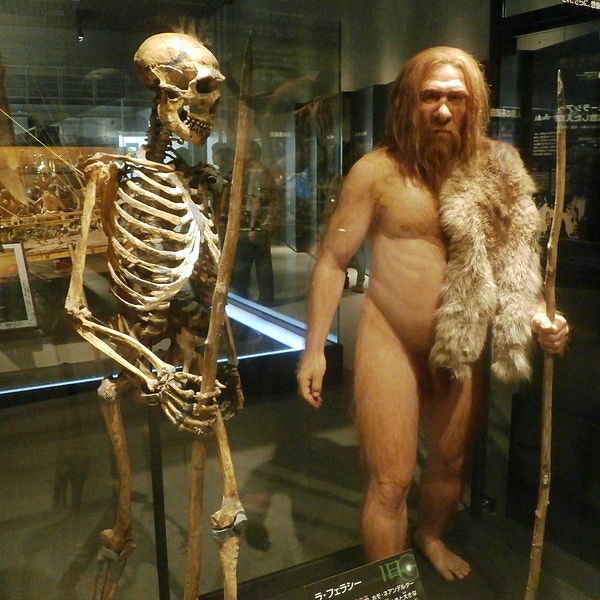
Okay, sure, I know better than to trust the word of a random blog on the internet written by some person whose identity and credentials are, as far as I can tell, totally unknown, but I find it an entertaining line of thought, especially when it comes to some Gloranthan creatures’ origins like the Tusk Riders.
By the way, that that skull recently discovered by Chinese archaeologists (and mentioned in the article) was widely reported as being from a “new branch of the human family tree”, but that claim isn’t widely accepted as far as I can tell, so it may be a bit premature to call it that until there’s more DNA material to analyze.
Curetes Street in Ancient Ephesus
Author/historian Marina Amaral shares some digital reconstructions of an Ancient Greek city that might help you better picture what, say, some Esrolian city might have looked like:
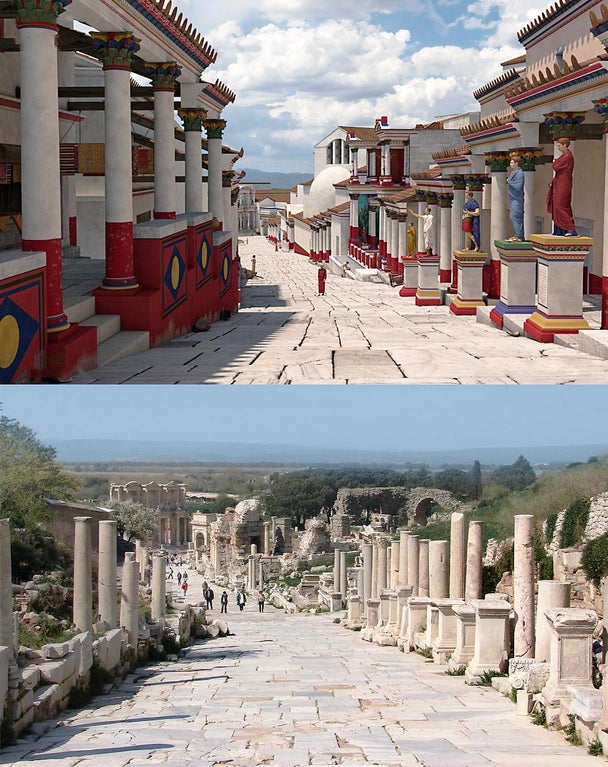
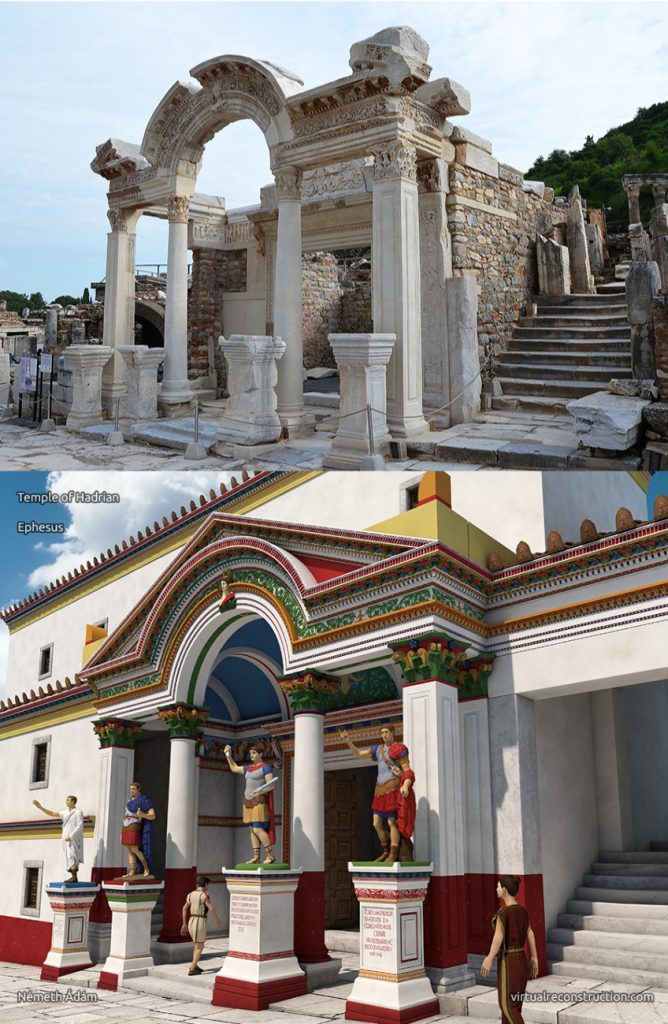
This city is Ephesus and is actually located in Turkey, even though it was built by Greek colonists. You can find more digital reconstructions on Ádám Németh’s website, including more pictures of Ephesus.
Tehotihuacan and Tikal
Do you want more digital reconstructions? Artist Anxo Miján Maroño has done some work for National Geographic that includes similar 3D rendering of ancient Mesoamerican cities like Tikal and Teotihuacan. This is all from period that happens a bit later than our usual Bronze Age focus (a handful of centuries CE), but at least Tikal has some architecture dating back to the 4th century BCE. I’m sure that regardless of the dates, you’ll love these colourful and inspiring pictures.
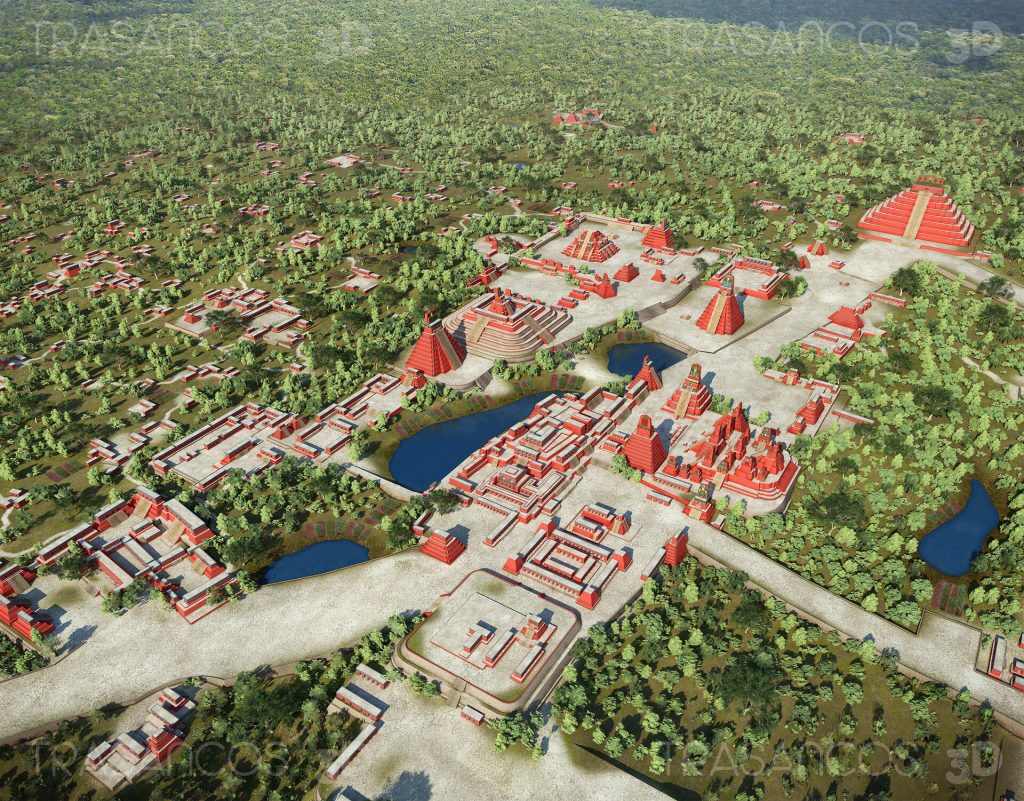
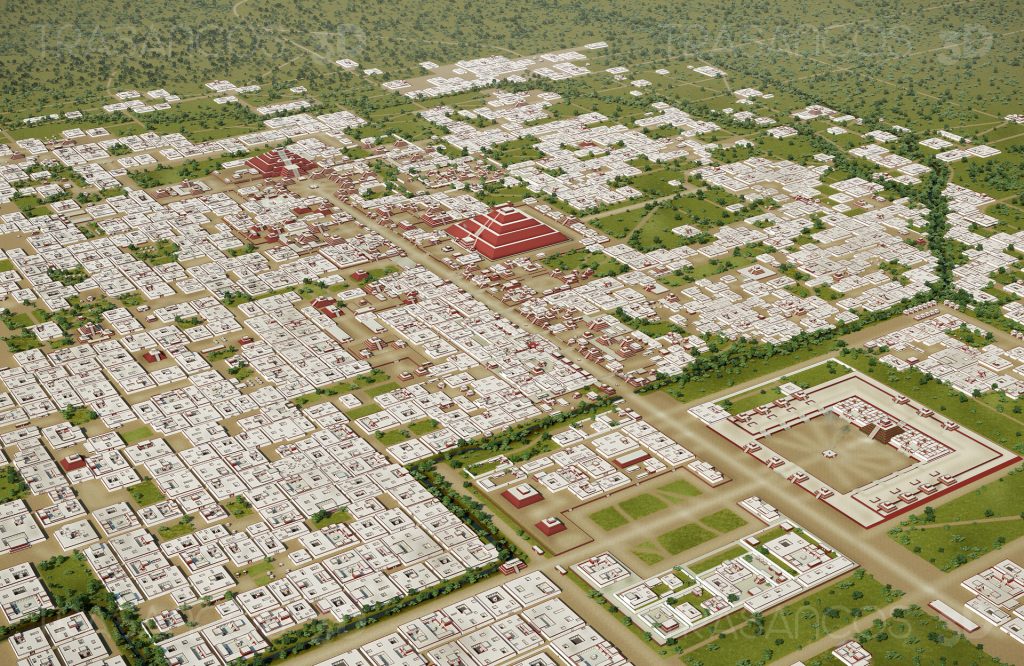
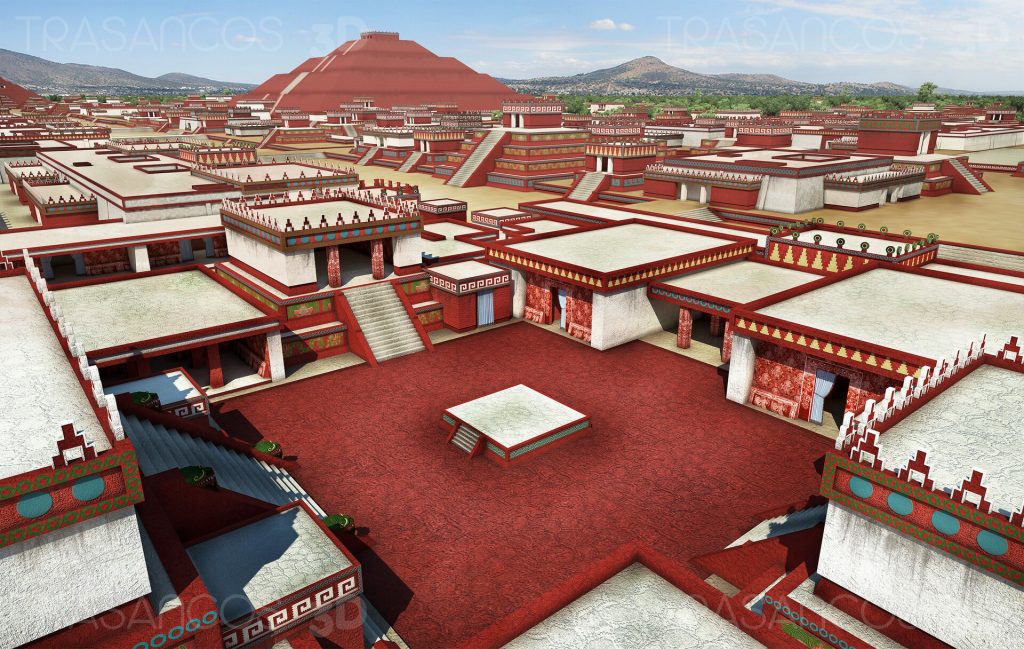
Thank you for reading
That’s it for this week! Please contact us with any feedback, question, or news item we’ve missed!
Errata: a previous version of this article described the well-circulated picture of Steve and Luise in SCA costume as a wedding picture. That was purely wishful thinking. I’m pretty sure they had a wicked wedding, though.



One comment on “Journal of Runic Studies #9”